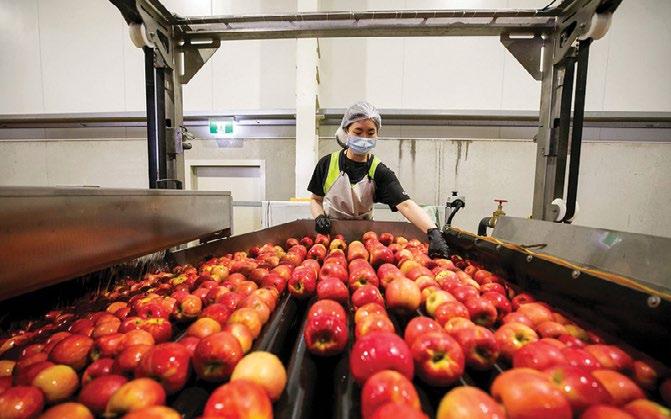
5 minute read
Food safety culture
what is it and why does it matter?
Advertisement
f FOOD safety culture is that part of organisational culture that relates to food safety beliefs, attitudes, perceptions, and behaviours.

BY ELIZABETH FRANKISH CONSULTANT MICROBIOLOGIST
Foodborne illness outbreaks from fresh produce are increasing, despite widespread use of food safety management systems.
In Australia over a 10-year period, more than 93 produce-associated outbreaks were recorded causing over 300 hospitalisations and at least eight deaths. Economic losses to the industry from dumped product, lost sales, reputational damage, and compensation, therefore, are significant. The causes identified, including poor hygiene and sanitation by food handlers, and contaminated equipment are factors influenced directly or indirectly by food handler behaviour.
Evidence is building that improving food safety culture contributes to better food safety outcomes and reduces the cost of food safety control.
What is a food safety culture?
Food safety culture is that part of organisational culture that relates to food safety beliefs, attitudes, perceptions, and behaviours. However, food safety culture is a complex combination of technological, managerial, and organisational conditions, human factors, and the FSMS (Food Safety Management System). Food safety culture defined:
“Shared values, beliefs and norms that affect mindset and behaviour toward food safety in, across and throughout an organization.” “Food safety culture in a business is how everyone (owners, managers, employees) thinks and acts in their daily job to make sure that the food they make or serve is safe. It’s about having pride in producing safe food every time, recognising that a good quality product must be safe to eat. Food safety is your top priority.”
FSANZ (Food Standards Australia New Zealand)
Measuring food safety culture
How does food safety culture relate to food safety management?
Preventative control measures and hazard analysis and critical control point (HACCP) plans are effective process operations control systems, but they ignore the human input factor to food safety management.
To effectively manage food safety risk, integrate:
Food science: • the hazards and how to mitigate the risk and
Behavioural science: • the will to mitigate the risk
Like performance evaluation of food safety management systems through validation, verification and monitoring, performance measurement of food safety culture defines its effectiveness and provides Food safety culture is an embedded requirement of Codex HACCP. a baseline from which to drive culture improvement. Measurement: • raises risk awareness • supports risk assessment • promotes commitment to food safety and program ownership • provides accountability from clear goals and expectations • provides focus on resource needs for improvement • supports internal audit processes • identifies weaknesses • informs decision-making and • helps avoid foodborne illness incidents and food recalls. The method chosen to measure food safety culture should systematically assess the people-based dimensions of leadership, commitment, communication, knowledge, risk awareness and perception, and beliefs, and the technical and organisational dimensions of the work environment, the management system, styles, and process. Measurement options include toolkits, maturity models and mixedmethod models. The basis of their measurement, their advantages and limitations are shown in Table 1 (overleaf).
The effectiveness of food safety management systems is dependent on how food handlers apply company policies and implement procedures in practice. As such, a positive food safety culture is a necessary requirement for the successful operation of a food safety management system, just like Good Manufacturing Practices (GMP) or Good Hygienic Practices (GHP).
Compliance is required
Food safety culture is an embedded requirement of Codex HACCP, and all GFSI-benchmarked quality assurance standards, including Freshcare, as part of management commitment and review, and improvements must be demonstrated.
Requirements will continue to evolve as the links between attitudes, perceptions, and practices of food safety risk control, and food safety management outcomes, are better understood.
TABLE 1. FOOD SAFETY CULTURE MEASUREMENT APPROACHES, THEIR ADVANTAGES, AND LIMITATIONS FOR HORTICULTURE.
Food safety culture measurement approaches Basis of measurement Toolkits e.g., FSANZ, 2019a • Questionnaires • Matrices assigning risk-based culture category • Benchmarking • Ideas for improvement • Good starting point • Snapshot in time • Insufficient elements provided for mature FSMS* • No integration with individual company FSMS
Maturity models e.g., Jespersen et al, 2016b • Questionnaires • Matrices assigning a scale of food safety culture maturity • Benchmarking • Identify areas for improvement • Provide a concept of the end goal • Snapshot in time • Participant perceptions influence results • Subjective • Appropriate action plan for improvement not easily resolved
Advantages Limitations
Mixed methods models e.g., Nyarugwe et al, 2018c • Questionnaires • Interviews • Observations • Document analysis • Microbial analysis • Focus groups • Assessment over time • Triangulation of data provides a more comprehensive interpretation of results • Ability to target specific areas for improvement • Objective assessment included • Time-consuming • Needs to be led by an experienced quality assurance person or consultant • Higher cost
* Food safety management system a. www.foodstandards.gov.au/foodsafety/culture/Pages/food-safety-culture-in-action.aspx b. Jespersen et al. (2016). Measurement of food safety culture using survey and maturity profiling tools. Food Control, 66, 174-182. c Nyarugwe et al. (2018). Food safety culture assessment using a comprehensive mixed-methods approach: A comparative study in dairy processing organisations in an emerging economy. Food Control, 18, 186-196.
Plant the culture in horticulture food safety management
The seed of food safety culture is sown from the top. Leadership and team building should clearly outline food safety performance expectations. Food handlers should be educated during training to understand why specific controls are in place. This builds trust that the expectations placed on them will lead to improved food safety. The likelihood of compliance with policies and procedures will then increase.

There are challenges …
Managing an effective food safety system while nurturing food safety culture is complex, time-consuming, and resource intensive but, ultimately, is cost-effective.
…and many opportunities
Focusing on food safety culture and its measurement will improve: • understanding of the prevailing culture • actual food safety and hygiene behaviour • how the management system supports food safety • guidance on appropriate interventions to improve performance • transparency in supply chains • business agility • business sustainability • social responsibility • risk mitigation for all stakeholders, the supply chain, investors, and insurers.
f GOOD food safety practice in action
Create ownership of the food safety system and think quality and safety = profit
MORE INFORMATION
The research for this article was supported by Apple and Pear Australia Ltd (APAL), Centre for Food Safety and Innovation, Tasmanian Institute of Agriculture, (University of Tasmania), ARC Centre for Food Safety in Fresh Produce (University of Sydney), and Fresh Produce Safety Centre Australia and New Zealand.
Fresh Produce Safety Centre Factsheet: Food Safety Culture https://fpsc-anz. com/publications-resources/ or contact Elizabeth Frankish 0407 446 937










